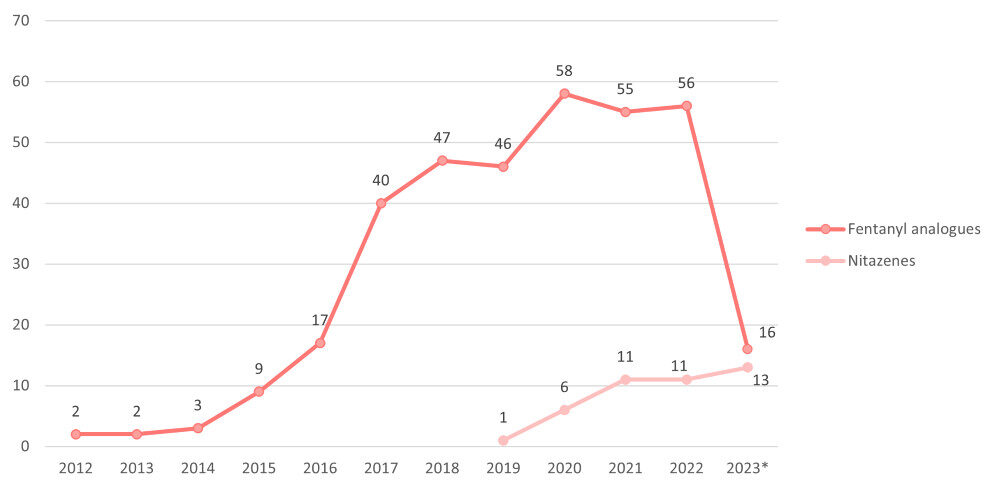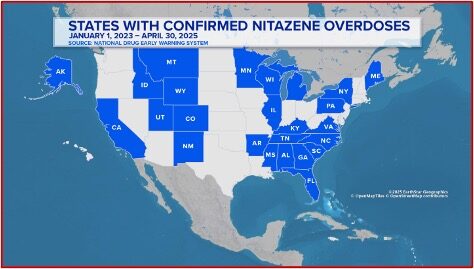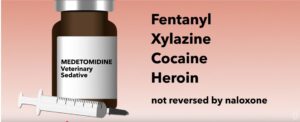TribLIVE.com published an online article on July 21, 2025, announcing that the Pennsylvania Department of Health temporarily labeled nitazenes as a Class I controlled substance, making it illegal to possess, distributes or manufacture them in the state. “Nitazenes were first developed in the 1950s as an alternative to morphine, but were never approved for medical use.” Their existence remained obscure until they began appearing in the illegal drug market in 2019. Deborah Bogan, the Secretary of Health in PA said: “Scheduling nitazenes, which have no acceptable medical use, as Class I substances provides law enforcement with the authority to crack down on its possession and distribution in Pennsylvania.”
The DEA Washington Division warned in June of 2022, that a new drug was emerging in the D.C. metropolitan area that was at dangerous and deadly as fentanyl—isotonitazene (aka nitazene or “ISO”). The DEA said it was first identified in the Midwest around 2019, and then moved into the southern states, and then up the Eastern seaboard. ISO was mixed into and then marketed as other drugs, causing overdoses in unsuspecting victims. These synthetic opioids can only be identified after a lab test, so people don’t realize what they’re buying and using until it’s too late.
In powder form, ISO can appear yellow, brown, or off-white in color. DEA regional forensic laboratories have seen this drug mixed into heroin and/or fentanyl (and marketed as common street drugs) with deadly consequences. However, in other parts of the country, ISO has already been seen pressed into counterfeit pills and falsely marketed as pharmaceutical medication (like Dilaudid “M-8” tablets and oxycodone “M30” tablets).
NewsNation published an article on September 12, 2025, warning the DEA found fake oxycodone pills laced with nitazene during a drug bust on New York’s Long Island in August of 2025. A retired FBI agent thought the nitazenes rage would be just like fentanyl—meaning it’s much more potent and less expensive. “So this is the perfect combination for drug dealers to sell to addicts because they’re looking for a greater high at a cheaper price.” Known as the “Frankenstein drug,” nitazene overdoses have been reported in 25 different states. See the following map, of confirmed nitazene overdoses between January 2023 and April 2025 found in the NewsNation article:
On September 16, 2025, Medical Express published “A forgotten opioid resurfaced as a lethal street drug,” and referred to a recently published article in Pain Medicine, “Nitazenes: Are Pain Physicians Aware of the Risks?” A co-author of the article in Pain Medicine from Vanderbilt said to Medical Express: “For patients, especially those with opioid use disorder or those exposed to illicit substances, nitazenes pose a serious and often hidden threat.” She added that these drugs may not show up on routine toxicology screens, with clinicians missing a crucial part of the diagnosis during overdose treatment. “Patients may also need higher or repeated doses of naloxone to reverse their effects.”
Another author of the Pain Medicine article from the University of Pittsburgh’s School of Medicine said the next steps were to generate human clinical data to better understand nitazenes’ effects, particularly their long-term health effects, and response to treatment like naloxone. He added: “The opioid crisis continues to evolve, and a thorough understanding of the mechanisms and risks of nitazenes is crucial for pain physicians, anesthesiologists and other providers.”
A Period of Hyper-Change
Time said in “What Comes After Fentanyl? In a ‘Period of Hyperchange,’ a New Opioid Is Emerging,” that nitazenes’ presence in the illicit drug market is likely underreported because the technology needed to identify them isn’t widely used in autopsies. A scientist at the University of North Carolina named Nabarun Dasgupta, who has been tracking nitazenes and other novel drugs, thought we were at a unique inflection point where the fentanyl supply was contracting.
In the coming months and years nitazene analogues and other drugs may become more prominent in the market and fill the gaps fentanyl is leaving. However, the sheer volume of fentanyl within the U.S. means a major shift in the opioid supply is not imminent.
But cracking down on one drug has led to the rise of another before, including in the case of fentanyl itself. And it’s possible the apparent increase in nitazenes across the country happening at the same time fentanyl’s presence is waning marks the beginning of a similar trend—though it may take years to establish, if it ever does.
While nitazene-related deaths have captured attention in Europe, research has yielded data indicating a great concentration of such deaths in North America. “In general, the United States and Canada really bear the majority of nitazene consumption around the world. . . “Anyone who has intimate knowledge of the nitazene supply would know, or should know, that nitazenes in the U.S. and Canada are far above in terms of prevalence anywhere else.”
The United Nations Office on Drugs and Crime (UNODC EWA) has charted the number of fentanyl analogues and nitazenes reported to them since 2012. Since the first report of a nitazene (isotonitazene) in 2019, the number of nitazenes reported increased to 13 in 2023. “Up to February 2024, nitazenes have been reported from Asia, Europe, North America, Oceania, and South America.” While the number of reported nitazenes has been increasing since 2019, the number of fentanyl analogues seems to dropping drastically. See the link for charts of both the number of fentanyl analogues and nitazenes reported to UNODC EWA, and the number of countries and territories reporting fentanyl analogues and nitazenes.
There are clear signs of a rapid emergence and spread of nitazenes: Since 2021, the number of unique nitazenes reported from European countries has been higher each year than the number of unique fentanyl analogues. While North America continues to report high numbers of unique fentanyl analogues, the number of unique nitazenes identified is similar to Europe. The countries reporting the highest numbers of unique nitazenes, in descending order, are the United States, Canada, Latvia, Estonia, the United Kingdom, Sweden, and Germany. Since 2019, the most frequently reported nitazenes include istonitazene, metonitazene, protonitazene, etonitazepyne, and etazene, all of which have since been placed under international control.
The U.S. lacks a “uniform way of tracking drugs,” where the lack of such an infrastructure suggests the country’s reported data is deflated. This also makes it difficult to predict how the drug supply is going to change. In addition, the CDC categorizes synthetic opioid-related deaths without specifying if an overdose is thought to be from nitazenes or a combination of nitazenes and another drug, such as fentanyl. Budget requests for the fiscal year 2026 would slash $3.6 billion from the CDC’s budget, but it’s not yet clear to what extent the requested cuts will be made and specifically, how they would impact the CDC’s ability to categorize synthetic opioid-related deaths.
The Time article noted where enforcement pressure from the government is at least partially responsible for the emergence of new drugs in the illicit drug market. The U.S. fight to stop the spread of fentanyl has spanned both Democratic and Republican administrations. In his second term, President Trump has redoubled his efforts to crack down on fentanyl trafficking by targeting cartels and seeking to ramp up seizures and constrict the flow of people and products across the U.S.’s southern border. In July, President Trump signed the HALT Fentanyl Act, which classified fentanyl-related substances (FRS) as Schedule I drugs and increased the punishment for traffickers. Fentanyl, not its analogues, remains a Schedule II controlled substance, according to the DEA.
This kind of effort to combat one drug ultimately leading another to emerge would not be without precedent. [Nabarun] Dasgupta cited the “Iron Law of Prohibition,” which holds that drug markets begin to favor new products that are easier to trade, and potentially more potent, when law enforcement on a more common product intensifies. This dynamic was seen roughly ten years ago when heroin was largely replaced by fentanyl, which now dominates its predecessor in the U.S. market.
That transition happens gradually. The U.S’s detection infrastructure and the ways nitazenes move within the country’s drug market make it difficult to document. “There is no one consistent supply chain across all 50 states,” said an expert on harm reduction and policy. Regional and urban supply chains interact within their own bubbles across the country, developing at different rates and slowly introducing new substance like nitazenes into the market. “What we see when these new drugs take hold, is that they start off in one market, one region, and they start to saturate that geographic area, starting usually with a city, but then kind of spreading to the rural areas surrounding it.”
Fentanyl primarily comes to the U.S. through Mexico, while nitazenes are typically produced in China. They “merge and overlap at times,” but don’t directly influence each other because of their independent supply chains. Alex Krotulski, the program manager for the Center for Forensic Science Research and Education’s drug early warning system, said: “It is possible that if fentanyl decreases that nitazenes could increase, but that doesn’t have to necessarily be the case.”
The increasing and probably underreported presence of nitazenes in the U.S. does not come close to fentanyl at this point. However, the emergence of nitazenes is indicative of a drug market undergoing a time of unpredictable shifts and diversification, changing into something different and unknown. Nabarun Dasgupta said: “Fundamentally, an unregulated drug supply is going to always be changing. . . And we’re just at kind of a period of hyper-change that we’ve never seen before.”






